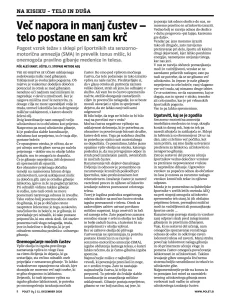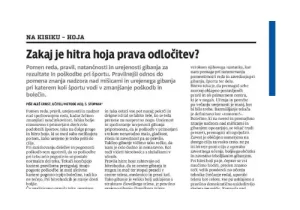The source article can be found by pressing the button on the bottom of the page.
Who is the ego? Ego allows us to change our surroundings to fulfill our needs and wishes or changes us to suit the environment.
Life has been long and increasingly alienated from the body and the natural laws and rules by which the body must function. That’s why we constantly face more and more obstacles in a shorter period, which creates a larger need for the ego to intervene – that’s how the ego takes the main role in the body-subconscious-conscious system.
Ego is the state of our consciousness that occurs when an obstacle is in our way, and it allows us to defeat or avoid it. Then we direct consciousness to a constricted state and change the mind’s functioning to direct the body’s functioning and create the appropriate pressure and movement needed to regulate the imbalance and increase homeostasis – thus perceiving a sense of satisfaction and state that we are okay.
The ego itself is neither good nor bad. It is necessary to regulate the environment’s attitude and provide the necessary conditions for life, satisfying needs, solving problems, and fulfilling desires.
Due to our surroundings’ entropy, the necessary balance needs to be reestablished repeatedly. For the most part, this is achieved through subconscious and reflex responses of the body’s systems, but stronger imbalances require the intervention of consciousness, which then forms into the ego.
The entropy of the environment? Entropy denotes the process of spontaneous disintegration of organized structures into more disordered (entropic) structures. The opposite of entropy is syntropy, which denotes only the organizational ability of nature or negative entropy.
The point with entropy is that it grows with time. And if we leave life to chance, it loses its order more and more. Weeds overgrow the gardens, and objects fall apart, the ground is affected by erosion, dust gathers on surfaces, even a diamond falls apart after a certain time.
The unavoidable trend is that these systems become more and more disorganized. And that’s why knowing entropy and its effects on our mood and life is important when learning about the AEQ method. Proper interpretation of the basic and most important physics law must be an integral part of learning the AEQ method because it allows a different view of the causes of the problems that cause people to seek help.
An example of entropy
In a box, you have 300 pieces of a puzzle. You empty it onto a table. Theoretically, the pieces all may fall into place immediately without you needing to put them together. But we all know that this in practice isn’t possible. Why? Because every piece has to fall on a certain place in a certain way, there is only one way to achieve order.
In reality, there are virtually countless ways puzzle pieces will fall on the table.
The absence of contact with the body makes it impossible for the consciousness to pinpoint the actual causes of the problem with sufficient precision, and often it doesn’t even dare to do so.
The same goes for maintaining a garden. It is theoretically possible for wind, animals, rain, and natural forces to shape the surface just how we wanted. And yet, we all know that that will never if we or someone else vests time, effort, and attention to planting and maintain order in the garden.
We also know that the garden’s chances of staying organized without our investment of time and effort are very small.
These two examples show us the point of entropy and how we prevent it and lower its negative effects.
Entropy is a measure for disorder; more options lead to disorder than the ones that lead to order. Over time, nothing escapes entropy; everything sooner or later disintegrates because its traction is constant, insensitive, and unstoppable. So over time, the disorder only increases.
The good news is that we can fight and slow down this unavoidable process and temporarily change it even into its opposite – syntropy. We can take our time and put the puzzle together. We attentively tend to the garden, clean our car, or tidy our apartment. We can organize a group of individuals and train them into a firefighter unit.
It is the fact that the universe is heading towards inevitable disorder that we need to invest our energy to create stability, structure, and complexity, which will be made easy due to our knowledge. A successful relationship demands attention and care; a successful family requires cooperation and clear communication; a clean home demands regular cleaning and maintenance.
Systems fall apart without the necessary effort and energy needed to maintain them.
These two facts – that clutter is a natural phenomenon of entropy that increases over time. We can influence this process by investing energy – reveal the meaning of life to us. We need to learn how to create enough “useful arrangements” that will be sufficiently resistant to entropy’s constant traction. This is most important because entropy is why the constantly smaller amount of energy we have available. However, raising usable orderliness and upgrading these abilities is the consciousness domain and when consciousness chooses to operate the ego.
Consciousness is both a passive and an active function. We cannot just turn the light of consciousness on, but we can instead direct where we want it.
A fully functioning consciousness can be represented like a light in the subconscious’s darkness, which allows us to see. But we can only see what is inside our cone of vision or the things the light shines upon. We can think of it as a flashlight that illuminates only a small area and leaves everything else in even bigger darkness. Similarly, a radar can only detect things located in the direction where the radar is pointing towards and is within the radar range, which depends on the radar’s strength and location.
Of course, we also have a subconscious system that “observes” the state of the environment to its full extent, even where consciousness is not directed. And from this work, we get feelings, which then direct the consciousness in a specific direction, so that we get more information and judge how to act accordingly.
We all know how to “something tells us” to look in a certain direction, or to feel that something is happening outside the beam of our light. Impulses of energy that enable awareness can also come from within us in the form of events that are strong enough to be felt. When, for example, we lack food, the feeling of hunger increases. When it is strong enough, we become aware of it. This awareness redirects our consciousness and allows us to regulate the need with appropriate actions and then focus on other states.
A beam of consciousness shines like a light on the events of our inside and outside world. There are never both worlds at the same time in a beam of light. If we focus on the outside world, then we reduce our focus on our inner world – and wrongly so. The state of hyperstimulation of the modern world draws our attention primarily to the outside world, leading to a lack of attention to the body’s inner world. This attention is needed to align processes, patterns, and habits with the present and body and mind changes due to time and entropy.
The light of consciousness
Consciousness is both a passive and an active function. We cannot just turn the light of consciousness on, but we can instead direct where we want it. We are generally open to seeing and feeling what is around us. This part of consciousness that is active in perception and response is called the ego.
Ego allows us to change our surroundings to fulfill our needs and wishes or changes us to suit the environment. We remove the obstacle from the path through the ego, and if this is not feasible, then we change the behavior to get around the obstacle. This triggers and requires muscle tone changes, conscious and acute, and changes when the obstacle is overcome or bypassed.
If the obstacle cannot be overcome or avoided, the ego must come to terms with it, even if such a state bothers it. And suppose such a relationship lasts for a long time (childhood and the child’s inability to overcome or avoid the parent). In that case, the ego’s need to deny the relationship’s reality to the obstacle is stronger. It leads to a chronically subconsciously raised tone – this allows self-denial and increasingly unbearable condition inside the membrane.
Which only affects the organism with faster entropy.
If the obstacle cannot be overcome or avoided, the ego must come to terms with it.
But how can ego turn on the body, which provides energy to function and carries out his orders? Freud pointed out that there is usually no need to raise a shield to the organism’s disturbance. These arousals are treated as pleasure or pain, or as impulses related to emotions, feelings, and experiences. Not perceiving these arousal poses a serious obstacle to the body’s ability to survive and fulfill itself.
And this is exactly what is becoming an increasingly important ability in the modern world, as life has long been increasingly alienated from the body and the natural laws and rules by which the body must function. That’s why we constantly face more and more obstacles in a shorter period, which creates a larger need for the ego to intervene – that’s how the ego takes the main role in the body-subconscious-conscious system.
Until our body stops us
Accordingly, the influence of the body on the thoughts of decisions and actions is increasingly reduced, leading to bodily imbalances caused by the lack of time, attention, and energy needed to keep the “body jigsaw puzzle” sufficiently orderly and over time becoming more complex and thus holds control of entropy in the body.
Simultaneously, it allows a high enough order in our surroundings to guarantee our family’s appropriate growth, especially children. They are completely dependent on our ability to recognize and understand their imbalances, react to them accordingly, and provide them with a regulated environment needed to develop into adults. And then into a parent that can provide the necessary conditions for the development of his child.
With the constant deterioration of the body’s influence on consciousness, there is an increasing unreality of consciousness’s functioning and an increasingly frequent and strong irregularity in recognizing the current situation. Thus, excessive bodily reactions to everyday relationships, anxiety, and excessive fears of the future, which cause discomfort in us, require the consciousness to do something and reduce such a condition.
In a box, you have 300 pieces of a puzzle. You empty it onto a table. Theoretically, the pieces all may fall into place immediately without you needing to put them together.
The absence of contact with the body prevents the consciousness from pinpointing the actual causes of the problem with sufficient precision and often does not even dare to do so, as it would have to admit that the real situation is much worse than it imagines. Thus, it seeks alternative ways of how to express and release the inner pressure. Work, sports, alcohol, nicotine, and sex are the most common ways of achieving this and offer a quick and short-term solution.
The problem arises from an unrealistic understanding of consequences and substituting causes and consequences with such expression methods. We do not achieve a change of causes for them, as the ego is directed in the wrong direction, and investing time, attention, and energy is ineffective.
Until the body stops us.
Such behavior can be recognized in all spheres of life, where ego-dominated people go through themselves (the body), even when there is no real need for it; these people thereby prove to themselves or others that they can and know, even if it destroys them in the long run and leads to a state of depression and frustration with themselves and their destiny.
Who is the ego in recreation?
In recreational road cycling, they are the people who can’t drive together with the rest of the team and by their body’s abilities. They are the people who race during training and train on races, teasing, and acting sarcastic towards others and are “encouraging” them to follow them and develop the same kind of behavior towards themselves like him.
In this way, group cycling turns into racing, where cyclists endanger others in traffic, and justifiably directs other road users’ anger. They drive without adapting to the weather and road conditions first. They are especially common at cycling marathons and events.
Therefore, I think it is good to know more about states of consciousness and the connections between body and consciousness so that we can better judge who and how we are and identify individuals who can help us and enable a more realistic attitude towards ourselves and develop appropriate respect for the body and bodily influence on our decisions and actions – such knowledge separates us from those who, in their egocentrism, inadvertently try to pull us into the same abyss into which they slide themselves.
A good enough mood and recognizing oneself and his past allow us to recognize emotional responses that aren’t aligned with reality and lead us to choices that aren’t in our long-term interest and don’t allow for the eventual increase of the complexity of our lives and relationships, which is necessary to control the constant influence of entropy – and all that without outside help from doctors, surgeons and pharmacists, which can become a constant in a selfish person’s life.





